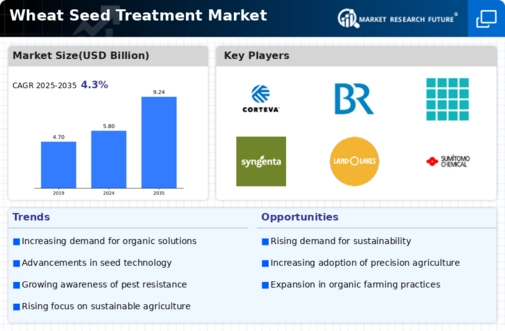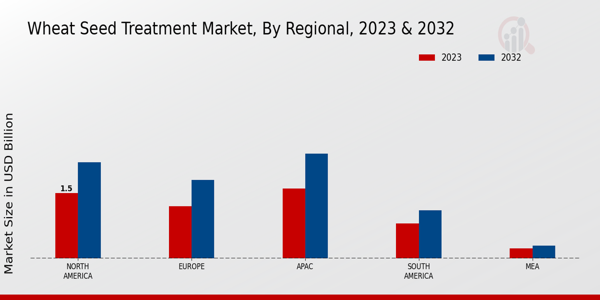Global Climate Change Impacts
The effects of global climate change are increasingly impacting agricultural practices, thereby influencing the Global Wheat Seed Treatment Market Industry. Changes in weather patterns, such as increased temperatures and altered precipitation, can lead to heightened pest and disease pressures on crops. As a response, farmers are turning to seed treatments as a means of mitigating these risks and ensuring crop resilience. This trend underscores the importance of developing seed treatment solutions that can withstand the challenges posed by climate change. The industry's growth trajectory suggests that addressing these environmental challenges will be crucial for future market expansion.
Government Initiatives and Support
Government policies and initiatives play a crucial role in shaping the Global Wheat Seed Treatment Market Industry. Many countries are implementing programs aimed at promoting sustainable agriculture and enhancing seed treatment practices. For example, subsidies for seed treatment products and research funding for innovative agricultural technologies are becoming more common. These initiatives not only encourage farmers to adopt advanced seed treatment methods but also contribute to the overall growth of the market. As a result, the industry is expected to expand significantly, with projections indicating a market value of 9.24 USD Billion by 2035.
Rising Demand for High-Yield Crops
The Global Wheat Seed Treatment Market Industry is experiencing an increasing demand for high-yield crops, driven by the need to enhance food security and meet the nutritional requirements of a growing global population. As agricultural practices evolve, farmers are seeking innovative solutions to improve crop productivity. For instance, the market is projected to reach 5.8 USD Billion in 2024, reflecting a significant investment in seed treatment technologies. This trend suggests that advancements in seed treatment can lead to improved germination rates and resistance to diseases, ultimately contributing to higher yields and better resource management.
Increasing Awareness of Seed Health
There is a growing awareness among farmers regarding the importance of seed health in achieving optimal crop yields, which is positively influencing the Global Wheat Seed Treatment Market Industry. Education and outreach programs are helping farmers understand the benefits of seed treatments, such as disease prevention and enhanced vigor. This heightened awareness is likely to drive demand for seed treatment solutions, as farmers recognize the potential for improved crop performance. Consequently, the market is witnessing a shift towards more proactive approaches in seed management, which may lead to increased adoption of seed treatment technologies.
Market Trends and Growth Projections
The Global Wheat Seed Treatment Market Industry is poised for substantial growth, with various trends indicating a positive trajectory. The market is expected to reach 5.8 USD Billion in 2024, and projections suggest it could grow to 9.24 USD Billion by 2035. This growth is underpinned by a CAGR of 4.33% from 2025 to 2035, reflecting increasing investments in seed treatment technologies and practices. The rising demand for sustainable agricultural solutions and the need for improved crop yields are likely to drive this expansion. As the industry evolves, it will be essential to monitor these trends to understand their implications for future market dynamics.
Technological Advancements in Seed Treatment
Technological innovations are transforming the Global Wheat Seed Treatment Market Industry, with new methods and products enhancing seed performance. The introduction of biological seed treatments, such as microbial inoculants, appears to be gaining traction among farmers. These advancements not only promote plant health but also reduce reliance on chemical inputs. As the market evolves, it is anticipated that the industry will grow at a CAGR of 4.33% from 2025 to 2035, indicating a robust interest in sustainable agricultural practices. This shift towards technology-driven solutions may lead to more efficient use of resources and improved crop resilience.




















